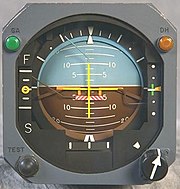
An attitude indicator (ADI), also known as gyro horizon or artificial horizon, is an instrument used in an aircraft to inform the pilot of the orientation of the aircraft relative to earth. It indicates pitch (fore and aft tilt) and bank (side to side tilt), and is a primary instrument for flight in instrument meteorological conditions. Attitude indicators also have significant application under visual flight rules, though some light aircraft do not have them installed.
Attitude indicators use a gyroscope to establish an inertial platform. The gyroscope is geared to a display that has two dimensions of freedom, simultaneously displaying pitch and bank. The display may be colored to indicate the horizon as the division between the two colored segments (typically blue for sky and brown for ground), and is intended to be intuitive to use. The actual bank angle is calibrated around the circumference of the instrument. The pitch angle is indicated by a series of calibration lines, each representing 5° or 10° of pitch.
Most Russian-built aircraft have a somewhat different design. The background display is colored as in a Western instrument, but moves up and down only to indicate pitch. A symbol representing the aircraft (which is fixed in a Western instrument) rolls left or right to indicate bank angle.
The pitch angle is relative to the ground, which is not as helpful as knowing the angle of attack of the wing, a much more critical measure of performance. The pilot must infer the total performance by using other instruments such as the airspeed indicator, altimeter, vertical speed indicator, and power instruments, e.g. an engine tachometer. "Performance = Attitude + Power".
Some attitude indicators can only tolerate a specific range of bank angles. If the aircraft rolls too steeply — while performing aerobatics, for example — the attitude indicator can "tumble" and become temporarily unusable. For this reason, some attitude indicators are fitted with a "cage" (a device to restore the gyroscope to an erect position). Most modern attitude indicators slowly re-erect back to level after a tumble. Others do not tumble at all.
On the attitude indicator are two white or yellow horizontal lines with a dot between them. The horizontal lines of this symbolic aircraft represent the wings and the dot represents its nose. If the symbolic aircraft dot is above the horizon line (more blue background) the aircraft is nose up. If the symbolic aircraft dot is below the horizon line (more brown background) the aircraft is nose down. When the dot and wings are on the horizon line, the aircraft is in level flight.
Individual mechanical gyros are slowly being replaced by Attitude and Heading Reference Systems (AHRS), which use solid-state or miniature gyroscopes (MEMS gyroscope) to supply aircraft orientation information, supplemented by magnetometers to supply heading information. Historically, heading information was supplied by a separate gyroscopic instrument known as a directional gyro (DG, or heading indicator). AHRS are able to provide three-axis information that can be shared with multiple devices in the aircraft, such as "glass cockpit" primary flight displays (PFDs). AHRS have been proven to be highly reliable and are in wide use in commercial and business aircraft. Recent advances in MEMS manufacturing have brought the price of FAA-certified AHRS down to less than $15,000, making them practical for general aviation aircraft. If an aircraft's ADIs have failed there is a standby ADI located in the center of the instrument panel, where other standby basic instruments such as the airspeed indicator and the attitude indicator are also available. These mostly mechanical standby instruments are available even if the electronic flight instruments fail.
External Links
- [Crossbow Technology ] :Air Data Sensors, Primary Flight Display Systems
| ||

No comments:
Post a Comment